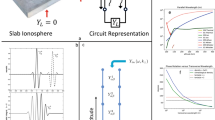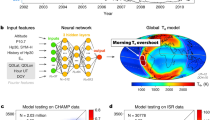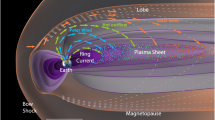Abstract
THE problem of the induction of electric currents in a non-uniform ionosphere is of interest in geomagnetism. It was first studied by Ashour and Price1 to determine the effects to be expected from the greater conductivity of the ionosphere over the sunlit hemisphere. Some time ago we considered the electric currents induced in a uniform anisotropic ionosphere (thus ignoring the difference in conductivity between the day and night hemispheres). We found that the anisotropy modifies only that part of the inducing field which is asymmetrical with respect to the geomagnetic axis, and that this asymmetrical part rotates about the geomagnetic axis from west to east at a rate depending on the Hall conductivity.
This is a preview of subscription content, access via your institution
Access options
Subscribe to this journal
Receive 51 print issues and online access
$199.00 per year
only $3.90 per issue
Buy this article
- Purchase on SpringerLink
- Instant access to full article PDF
Prices may be subject to local taxes which are calculated during checkout
Similar content being viewed by others
References
Ashour, A. A., and Price, A. T., Proc. Roy. Soc. A, 195, 198 (1948).
Author information
Authors and Affiliations
Rights and permissions
About this article
Cite this article
ASHOUR, A., FERRARO, V. Induction of Electric Currents in a Uniform Anisotropic Ionosphere. Nature 196, 260 (1962). https://doi.org/10.1038/196260a0
Issue date:
DOI: https://doi.org/10.1038/196260a0
This article is cited by
-
Motion of Current Systems in the Ionosphere
Nature (1963)



